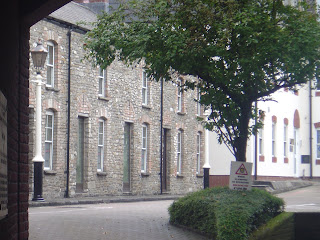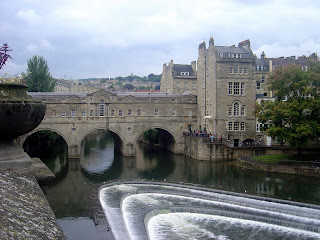 As I mentioned before, most of my time in Cardiff was spent at the Castle. It seems really weird to be walking down a modern day street, turn a corner and see a castle, however that's pretty much what Cardiff is like. A road runs right nest to the castle wall and the city literally is right next to the grounds. The back edge faces a park, so the castle looks a little less out of place.
As I mentioned before, most of my time in Cardiff was spent at the Castle. It seems really weird to be walking down a modern day street, turn a corner and see a castle, however that's pretty much what Cardiff is like. A road runs right nest to the castle wall and the city literally is right next to the grounds. The back edge faces a park, so the castle looks a little less out of place. While it may appear like there was less to see at Cardiff Castle than Tower of London, I was not disappointed and I LOVED it there. It rained off and on throughout my visit, but I enjoyed wandering and listening to the audio guide's stories as well as walking through the interior of the wall and watching the rain pour down outside.
While it may appear like there was less to see at Cardiff Castle than Tower of London, I was not disappointed and I LOVED it there. It rained off and on throughout my visit, but I enjoyed wandering and listening to the audio guide's stories as well as walking through the interior of the wall and watching the rain pour down outside.  I entered the castle by the Black Tower. This tower sits along the outer wall and when it was constructed, there was a wall which stretched between the tower and Norman Keep. That wall was destroyed during a rebellion when much of Cardiff was burned and destroyed. Years later, a small wall (somewhere between 3-4 feet high) was built and now sits where the old wall used to be located. Along the side of the Black Tower, you can see where the first wall would have been attached to allow guards in the wall to be able to to retreat into the keep.
I entered the castle by the Black Tower. This tower sits along the outer wall and when it was constructed, there was a wall which stretched between the tower and Norman Keep. That wall was destroyed during a rebellion when much of Cardiff was burned and destroyed. Years later, a small wall (somewhere between 3-4 feet high) was built and now sits where the old wall used to be located. Along the side of the Black Tower, you can see where the first wall would have been attached to allow guards in the wall to be able to to retreat into the keep.  Norman Keep sits on a hill in the middle the walls of the castle. Surrounded by a moat and sitting high up upon it's grassy mound, it really is a beautiful site to see. You are actually able to climb to go inside it and even climb to the top where the flag flies from! I of course chose to do this.
Norman Keep sits on a hill in the middle the walls of the castle. Surrounded by a moat and sitting high up upon it's grassy mound, it really is a beautiful site to see. You are actually able to climb to go inside it and even climb to the top where the flag flies from! I of course chose to do this.  Now the audio guide, did warn me that it was over 100 steps to get to the very top, but it did not warn how steep and crowded those stairs would be. Regardless, it was definitely worth it. After climbing the initial set of stairs to get to the keep, you arrive in a big grassy area.
Now the audio guide, did warn me that it was over 100 steps to get to the very top, but it did not warn how steep and crowded those stairs would be. Regardless, it was definitely worth it. After climbing the initial set of stairs to get to the keep, you arrive in a big grassy area. While the walls appear circular, if you look very closely, you will find that it is actually a dodecagon (12 sided polygon). You can also tell that the walls would have had rooms along the edges at one point. After wandering around this you are able to climb more stairs, first to a small room, then a landing, then to the top of the tower.
While the walls appear circular, if you look very closely, you will find that it is actually a dodecagon (12 sided polygon). You can also tell that the walls would have had rooms along the edges at one point. After wandering around this you are able to climb more stairs, first to a small room, then a landing, then to the top of the tower.
From the top of the tower you can look across at the grounds and the surrounding city, and is quite odd to see modern buildings so close to the old fortress.
 As I was on top of the keep, it began to rain, so I worked my way back out of the keep and took a wander through the walls. Yes, that's right, you can walk around inside the actual walls. Parts of the wall date back to Roman times as early as Emperor Nero. And it is pretty neat to walk through the walls glancing outside at the pouring rain.
As I was on top of the keep, it began to rain, so I worked my way back out of the keep and took a wander through the walls. Yes, that's right, you can walk around inside the actual walls. Parts of the wall date back to Roman times as early as Emperor Nero. And it is pretty neat to walk through the walls glancing outside at the pouring rain. Once the rain cleared up a bit, I wandered outside again. On the corner of the wall, you can see the clock tower which is very ornamental and has brightly painted figures which are actually larger than real hman beings! The tower is built on top of a Roman Bulwark. The colors were recently restored a bit during a conservation project.
Once the rain cleared up a bit, I wandered outside again. On the corner of the wall, you can see the clock tower which is very ornamental and has brightly painted figures which are actually larger than real hman beings! The tower is built on top of a Roman Bulwark. The colors were recently restored a bit during a conservation project.Along the western wall of the grounds is a palace. You are able to tour through a lot of the palace at your own pace and it is really quite exquisite.

 Most of the rooms in the palace are intricately designed and decorated. The banquet hall was my favorite as the walls were covered with beautiful drawings and moldings which gave the room life and character. These also had been recently restored to bring back some of the color.
Most of the rooms in the palace are intricately designed and decorated. The banquet hall was my favorite as the walls were covered with beautiful drawings and moldings which gave the room life and character. These also had been recently restored to bring back some of the color. In the castle grounds also sits a trebuchet. I unfortunately found out that if I had done a little research and come on a different weekend that I could have watched it be fired! Which would have been AWESOME. Also, if I wasn't going home this Saturday, I could have returned in September for the cheese festival. Though it would probably be much more crowded on an event day, and I liked that it wasn't overly crowded on my rainy visit.
In the castle grounds also sits a trebuchet. I unfortunately found out that if I had done a little research and come on a different weekend that I could have watched it be fired! Which would have been AWESOME. Also, if I wasn't going home this Saturday, I could have returned in September for the cheese festival. Though it would probably be much more crowded on an event day, and I liked that it wasn't overly crowded on my rainy visit.  Inside the visitor center area, if you go down to the basement, you will find a museum entitled 'Firing Line'. It is all about the history of Welsh Soldiers and has many neat uniforms, swords and badges from Welsh history. You could even try on some replicas of various uniforms, and feel the weight of old guns and army packs. While it was relatively small and seemed unnoticed by most visitors, it was definitely worth the time to look around it.
Inside the visitor center area, if you go down to the basement, you will find a museum entitled 'Firing Line'. It is all about the history of Welsh Soldiers and has many neat uniforms, swords and badges from Welsh history. You could even try on some replicas of various uniforms, and feel the weight of old guns and army packs. While it was relatively small and seemed unnoticed by most visitors, it was definitely worth the time to look around it. I spent a little more time wandering around the grounds a bit before departing, and enjoying the view and structures:
 and took a brief walk around the outside of the Castle before continuing on my way through Cardiff. Overall, definitely my favorite place I saw in Cardiff, and one of my favorite places so far this summer! Cheers!
and took a brief walk around the outside of the Castle before continuing on my way through Cardiff. Overall, definitely my favorite place I saw in Cardiff, and one of my favorite places so far this summer! Cheers!





































